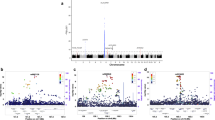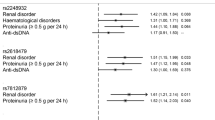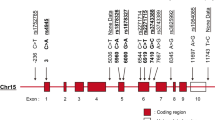Abstract
The major histocompatibility complex (MHC) class II transactivator gene (CIITA) encodes an important transcription factor required for human leukocyte antigens (HLA) class II MHC-restricted antigen presentation. MHC genes, including the HLA class II DRB1*03:01 allele, are strongly associated with systemic lupus erythematosus (SLE). Recently the rs4774 CIITA missense variant (+1632G/C) was reported to be associated with susceptibility to multiple sclerosis. In the current study, we investigated CIITA, DRB1*03:01 and risk of SLE using a multi-stage analysis. In stage 1, 9 CIITA variants were tested in 658 cases and 1363 controls (N=2021). In stage 2, rs4774 was tested in 684 cases and 2938 controls (N=3622). We also performed a meta-analysis of the pooled 1342 cases and 4301 controls (N=5643). In stage 1, rs4774*C was associated with SLE (odds ratio (OR)=1.24, 95% confidence interval (95% CI)=1.07–1.44, P=4.2 × 10−3). Similar results were observed in stage 2 (OR=1.16, 95% CI=1.02–1.33, P=8.5 × 10−3) and the meta-analysis of the combined data set (OR=1.20, 95% CI=1.09–1.33, Pmeta=2.5 × 10−4). In all three analyses, the strongest evidence for association between rs4774*C and SLE was present in individuals who carried at least one copy of DRB1*03:01 (Pmeta=1.9 × 10−3). Results support a role for CIITA in SLE, which appears to be stronger in the presence of DRB1*03:01.
This is a preview of subscription content, access via your institution
Access options
Subscribe to this journal
Receive 6 digital issues and online access to articles
$119.00 per year
only $19.83 per issue
Buy this article
- Purchase on Springer Link
- Instant access to full article PDF
Prices may be subject to local taxes which are calculated during checkout
Similar content being viewed by others
References
Chang CH, Flavell RA . Class II transactivator regulates the expression of multiple genes involved in antigen presentation. J Exp Med 1995; 181: 765–767.
Steimle V, Otten LA, Zufferey M, Mach B . Complementation cloning of an MHC class II transactivator mutated in hereditary MHC class II deficiency (or bare lymphocyte syndrome). Cell 1993; 75: 135–146.
Muhlethaler-Mottet A, Otten LA, Steimle V, Mach B . Expression of MHC class II molecules in different cellular and functional compartments is controlled by differential usage of multiple promoters of the transactivator CIITA. EMBO J 1997; 16: 2851–2860.
Bronson PG, Caillier S, Ramsay PP, McCauley JL, Zuvich RL, De Jager PL et al. CIITA variation in the presence of HLA-DRB1*1501 increases risk for multiple sclerosis. Hum Mol Genet 2010; 19: 2331–2340.
Barcellos LF, May SL, Ramsay PP, Quach HL, Lane JA, Nititham J et al. High-density SNP screening of the major histocompatibility complex in systemic lupus erythematosus demonstrates strong evidence for independent susceptibility regions. PLoS Genet 2009; 5: e1000696.
de Bakker PI, McVean G, Sabeti PC, Miretti MM, Green T, Marchini J et al. A high-resolution HLA and SNP haplotype map for disease association studies in the extended human MHC. Nat Genet 2006; 38: 1166–1172.
Gateva V, Sandling JK, Hom G, Taylor KE, Chung SA, Sun X et al. A large-scale replication study identifies TNIP1, PRDM1, JAZF1, UHRF1BP1 and IL10 as risk loci for systemic lupus erythematosus. Nat Genet 2009; 41: 1228–1233.
Zhang Z, Cheng Y, Zhou X, Li Y, Gao J, Han J et al. Polymorphisms at 16p13 are associated with systemic lupus erythematosus in the Chinese population. J Med Genet 2011; 48: 69–72.
Sherry ST, Ward MH, Kholodov M, Baker J, Phan L, Smigielski EM et al. dbSNP: the NCBI database of genetic variation. Nucleic Acids Res 2001; 29: 308.
Spencer CCA, Deloukas P, Hunt S, Mullikin J, Myers S, Silverman B et al. The influence of recombination on human genetic diversity. PLoS Genet 2006; 2: e148.
Ng PC, Henikoff S . Predicting deleterious amino acid substitutions. Genome Res 2001; 11: 863–874.
Woolfe A, Mullikin JC, Elnitski L . Genomic features defining exonic variants that modulate splicing. Genome Biol 2010; 11: R20.
Kim TW, Park HJ, Choi EY, Jung KC . Overexpression of CIITA in T cells aggravates Th2-mediated colitis in mice. J Korean Med Sci 2006; 21: 877–882.
Sanchez E, Sabio JM, Jimenez-Alonso J, Callejas JL, Camps M, de Ramon E et al. Study of two polymorphisms of the MHC2TA gene with systemic lupus erythematosus. Rheumatology 2008; 47: 102–103.
Okamoto H, Kaneko H, Terai C, Kamatani N . Protective effect of A at position −168 in the type III promoter of the MHCIITA gene in systemic lupus erythematosus. Ann Rheum Dis 2007; 66: 1263–1264.
Linga-Reddy MVP, Gunnarsson I, Svenungsson E, Sturfelt G, Jonsen A, Truedsson L et al. A polymorphic variant in the MHC2TA gene is not associated with systemic lupus erythematosus. Tissue Antigens 2007; 70: 412–414.
Hindorff LA, Junkins HA, Hall PN, Mehta JP . Available at www.genome.gov/gwastudies. Accessed 6/7/2010 In.
Kozyrev SV, Abelson A-K, Wojcik J, Zaghlool A, Linga Reddy MVP, Sanchez E et al. Functional variants in the B-cell gene BANK1 are associated with systemic lupus erythematosus. Nat Genet 2008; 40: 211–216.
Hom G, Graham RR, Modrek B, Taylor KE, Ortmann W, Garnier S et al. Association of systemic lupus erythematosus with C8orf13-BLK and ITGAM-ITGAX. N Engl J Med 2008; 358: 900–909.
Harley JB, Alarcon-Riquelme ME, Criswell LA, Jacob CO, Kimberly RP, Moser KL et al. Genome-wide association scan in women with systemic lupus erythematosus identifies susceptibility variants in ITGAM, PXK, KIAA1542 and other loci. Nat Genet 2008; 40: 204–210.
Graham RR, Cotsapas C, Davies L, Hackett R, Lessard CJ, Leon JM et al. Genetic variants near TNFAIP3 on 6q23 are associated with systemic lupus erythematosus. Nat Genet 2008; 40: 1059–1061.
Yang J, Yang W, Hirankarn N, Ye DQ, Zhang Y, Pan HF et al. ELF1 is associated with systemic lupus erythematosus in Asian populations. Hum Mol Genet 2011; 20: 601–607.
Han JW, Zheng HF, Cui Y, Sun LD, Ye DQ, Hu Z et al. Genome-wide association study in a Chinese Han population identifies nine new susceptibility loci for systemic lupus erythematosus. Nat Genet 2009; 41: 1234–1237.
Yang W, Shen N, Ye DQ, Liu Q, Zhang Y, Qian XX et al. Genome-wide association study in Asian populations identifies variants in ETS1 and WDFY4 associated with systemic lupus erythematosus. PLoS Genet 2010; 6: e1000841.
Lawrence R, Day-Williams AG, Mott R, Broxholme J, Cardon LR, Zeggini E . GLIDERS—a web-based search engine for genome-wide linkage disequilibrium between HapMap SNPs. BMC Bioinformatics 2009; 10: 367.
Yang J, Benyamin B, McEvoy BP, Gordon S, Henders AK, Nyholt DR et al. Common SNPs explain a large proportion of the heritability for human height. Nat Genet 2010; 42: 565–569.
Swanberg M, Lidman O, Padyukov L, Eriksson P, Akesson E, Jagodic M et al. MHC2TA is associated with differential MHC molecule expression and susceptibility to rheumatoid arthritis, multiple sclerosis and myocardial infarction. Nat Genet 2005; 37: 486–494.
Bronson PG, Criswell LA, Barcellos LF . The MHC2TA −168A/G polymorphism and risk for rheumatoid arthritis: a meta-analysis of 6861 patients and 9270 controls reveals no evidence for association. Ann Rheum Dis 2008; 67: 933–936.
Bronson PG, Ramsay PP, Seldin MF, Gregersen PK, Criswell LA, Barcellos LF . CIITA is not associated with risk of developing rheumatoid arthritis. Genes Immun 2011; 12: 235–238.
McGovern DP, Gardet A, Torkvist L, Goyette P, Essers J, Taylor KD et al. Genome-wide association identifies multiple ulcerative colitis susceptibility loci. Nat Genet 2010; 42: 332–337.
Dubois PC, Trynka G, Franke L, Hunt KA, Romanos J, Curtotti A et al. Multiple common variants for celiac disease influencing immune gene expression. Nat Genet 2010; 42: 295–302.
Tian C, Plenge RM, Ransom M, Lee A, Villoslada P, Selmi C et al. Analysis and application of European genetic substructure using 300 K SNP information. PLoS Genet 2008; 4: 29–39.
Kosoy R, Nassir R, Tian C, White PA, Butler LM, Silva G et al. Ancestry informative marker sets for determining continental origin and admixture proportions in common populations in America. Hum Mutat 2009; 30: 69–78.
Falush D, Stephens M, Pritchard JK . Inference of population structure using multilocus genotype data: linked loci and correlated allele frequencies. Genetics 2003; 164: 1567–1587.
Wellcome Trust Case Control Consortium. Genome-wide association study of 14,000 cases of seven common diseases and 3,000 shared controls. Nature 2007; 447: 661–678.
Barrett JC, Fry B, Maller J, Daly MJ . Haploview: analysis and visualization of LD and haplotype maps. Bioinformatics 2005; 21: 263–265.
International_HapMap_Consortium.. A haplotype map of the human genome. Nature 2005; 437: 1299–1320.
Purcell S, Neale B, Todd-Brown K, Thomas L, Ferreira MA, Bender D et al. PLINK: a tool set for whole-genome association and population-based linkage analyses. Am J Hum Genet 2007; 81: 559–575.
Clarke GM, Pettersson FH, Morris AP . A comparison of case-only designs for detecting gene × gene interaction in rheumatoid arthritis using genome-wide case-control data in Genetic Analysis Workshop 16. BMC Proc 2009; 3 (Suppl 7): S73.
Yang Q, Khoury MJ, Sun F, Flanders WD . Case-only design to measure gene-gene interaction. Epidemiology 1999; 10: 167–170.
Acknowledgements
We would like to thank the International MS Genetics Consortium for contributing genetic data to this study. We also thank Suzanne May, Farren Briggs, Alan Hubbard and Gary Artim. This work was supported by an REF/Abbott Graduate Student Achievement Award from the American College of Rheumatology (PB), a Kirkland Scholar Award from the Mary Kirkland Center for Lupus Research (LAC), the Alliance for Lupus Research (JBH, KLM, LAC), the US Department of Veterans Affairs (JBH), Lupus Foundation Minnesota (KLM) and NIH grants F31-AI075609 (PGB), R01-AR44804 (LAC), R01-AR052300 (LAC), K24-AR02175 (LAC), P60 AR053308 (LAC), P01 AR049084 (JBH), R01 AR42460 (JBH), R01 AR043274-14 (KLM) and N01 AR62277 (JBH) from NIAMS, R37 AI24717 (JBH), P01 AI083194 (JBH), 5R01 A1063274-06 (PMG) from NIAID, and P20-RR020143 (JBH) from NCRR. The contents of this article are solely the responsibility of the authors and do not necessarily represent the official views of the NIH, NIAID or NCRR. This study was performed in part in the General Clinical Research Center, Moffitt Hospital, UCSF, with funds provided by the National Center for Research Resources, 5-M01-RR-00079, US Public Health Service. This study makes use of data generated by the WTCCC; a full list of the investigators who contributed to the generation of the data is available from www.wtccc.org.uk, and funding for the project was provided by the Wellcome Trust under award 076113.
Author information
Authors and Affiliations
Corresponding author
Ethics declarations
Competing interests
The authors declare no conflict of interest.
Additional information
Supplementary Information accompanies the paper on Genes and Immunity website
Supplementary information
Rights and permissions
About this article
Cite this article
Bronson, P., Goldstein, B., Ramsay, P. et al. The rs4774 CIITA missense variant is associated with risk of systemic lupus erythematosus. Genes Immun 12, 667–671 (2011). https://doi.org/10.1038/gene.2011.36
Received:
Accepted:
Published:
Issue Date:
DOI: https://doi.org/10.1038/gene.2011.36
Keywords
This article is cited by
-
NOD-like receptors in autoimmune diseases
Acta Pharmacologica Sinica (2021)
-
Genetic association analyses implicate aberrant regulation of innate and adaptive immunity genes in the pathogenesis of systemic lupus erythematosus
Nature Genetics (2015)



